Compensatory hyperplasia - Study guides, Class notes & Summaries
Looking for the best study guides, study notes and summaries about Compensatory hyperplasia? On this page you'll find 1179 study documents about Compensatory hyperplasia.
Page 4 out of 1.179 results
Sort by
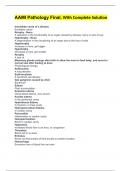
-
AAMI Pathology Final, With Complete Solution
- Exam (elaborations) • 13 pages • 2024
-
 Topscorer1
Topscorer1
-
- $13.98
- 1x sold
- + learn more
AAMI Pathology Final, With Complete Solution Immediate cause of a disease Excitatory cause Atrophy - Noun A reduction in the functionality of an organ caused by disease, injury or lack of use Hypotrophy - Noun A degeneration in the functioning of an organ due to the loss of cells Hypertrophy Increase or more, get bigger Hypotrophy Decrease or less, get smaller Atrophy A lack of Mammary glands enlarge after birth to allow the mom to feed baby, and revert to normal size after feedin...
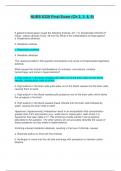
-
NURS 6320 Final Exam (Ch 2, 3, 8, 9) | Answered with Rationales
- Exam (elaborations) • 24 pages • 2025
-
 Jumuja
Jumuja
-
- $20.49
- + learn more
NURS 6320 Final Exam (Ch 2, 3, 8, 9) | Answered with Rationales A patient's blood gases reveal the following findings: pH, 7.3; bicarbonate (HCO3) 27 mEq/L; carbon dioxide (CO2), 58 mm Hg. What is the interpretation of these gases? a. Respiratory alkalosis b. Metabolic acidosis c. Respiratory acidosis d. Metabolic alkalosis The values provided in this question characterize only acute uncompensated respiratory acidosis. What causes the clinical manifestations of confusion, convulsions, cere...

-
PATHOPHYSIOLOGY EXAM 1 2024/ 100 QUESTIONS WITH CORRECT DETAILED AND VERIFIED ANSWERS AND RATIONALES/LATEST UPDATE 2024-2025
- Exam (elaborations) • 21 pages • 2024
-
 Nerdsplug
Nerdsplug
-
- $13.99
- + learn more
PATHOPHYSIOLOGY EXAM 1 2024/ 100 QUESTIONS WITH CORRECT DETAILED AND VERIFIED ANSWERS AND RATIONALES/LATEST UPDATE 1. A patient is found to have liver disease, resulting in the removal of a lobe of his liver. Adaptation to the reduced size of the liver leads to of the remaining liver cells. A. Metaplasia B. Organ atrophy C. Compensatory hyperplasia D. Physiologic hyperplasia: C
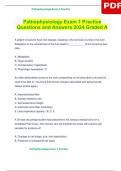
-
Pathophysiology Exam 1 Practice Questions and Answers 2024 Graded A
- Exam (elaborations) • 29 pages • 2024
-
 PossibleA
PossibleA
-
- $14.99
- + learn more
A patient is found to have liver disease, resulting in the removal of a lobe of his liver. Adaptation to the reduced size of the liver leads to ___________ of the remaining liver cells. A. Metaplasia B. Organ atrophy C. Compensatory hyperplasia D. Physiologic hyperplasia - C An older adult patient comes to the clinic complaining of not being able to do what he used to be able to. You know that normal changes associated with aging include: (Select all that apply.) A. Improved blood...
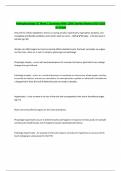
-
Pathophysiology UC Week 1 Questions With 100% Verified Review 2024-2025 A+ Grade
- Exam (elaborations) • 9 pages • 2024
-
 Accurate
Accurate
-
- $15.99
- + learn more
Pathophysiology UC Week 1 Questions With 100% Verified Review A+ Grade Describe the cellular adaptations that occur during atrophy, hypertrophy, hyperplasia, dysplasia, and metaplasia and identify conditions under which each can occur. - ANS-Atrophy - is the decrease in cell size (pg. 50) Atrophy can affect organs but most commonly affects skeletal muscle, the heart, secondary sex organs, and the brain, there are 2 parts to atrophy, physiologic and pathologic Physiologic atrophy...
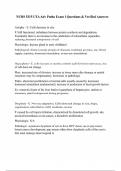
-
NURS 5315 UTA Adv Patho Exam 1 Questions & Verified Answers
- Exam (elaborations) • 67 pages • 2024
-
 Kingamor
Kingamor
-
- $12.00
- + learn more
Atrophy - E. Cells decrease in size P. Still functional; imbalance between protein synthesis and degradation. Essentially there is an increase in the catabolism of intracellular organelles, reducing structural components of cell Physiologic: thymus gland in early childhood Pathological: disuse (muscle atrophy d/ decrease workload, pressure, use, blood supply, nutrition, hormonal stimulation, or nervous stimulation) Hyperplasia - E: cells increase in number, mitosis (cell division) must oc...
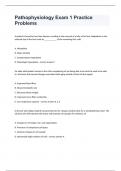
-
Pathophysiology Exam 1 Practice Problems questions and answers graded A+
- Exam (elaborations) • 27 pages • 2024
- Available in package deal
-
 Sakayobako30
Sakayobako30
-
- $17.99
- + learn more
Pathophysiology Exam 1 Practice Problems A patient is found to have liver disease, resulting in the removal of a lobe of his liver. Adaptation to the reduced size of the liver leads to ___________ of the remaining liver cells. A. Metaplasia B. Organ atrophy C. Compensatory hyperplasia D. Physiologic hyperplasia - correct answer C An older adult patient comes to the clinic complaining of not being able to do what he used to be able to. You know that normal changes associated with agin...
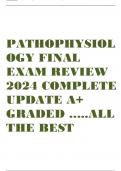
-
NUR 7560 PATHOPHYSIOLOGY FINAL EXAM REVIEW 2024 COMPLETE UPDATE A+ GRADED
- Exam (elaborations) • 39 pages • 2024
- Available in package deal
-
 Quizzguru
Quizzguru
-
- $10.99
- + learn more
Differences b/w dysplasia, hyperplasia, physiological (6 q) a. Dysplasia = deranged growth immature cells of a specific tissue that results in atypical cells (cells vary in size, shape, and appearance) i. often a precursor of cancer (ex. cervical dysplasia – cells start to change + become precancerous or cancerous) ii. * Google: Dysplasia refers to an abnormality in the maturation of cells within a tissue; consists of an increase in immature cells with a corresponding decrease in mature...

-
NURS 5315 ADV PATHO ACTUAL TEST BANK 1 ( advanced patho ) / 500 + QUESTIONS AND CORRECT ANSWERED SOLUTIONS 2025/2026 LATEST UPDATE !!!
- Exam (elaborations) • 73 pages • 2025
-
 Tutor23
Tutor23
-
- $11.49
- + learn more
1. Atrophy CORRECT ANSWER / EXPLANATION E.Cells decrease in size P. Still functional; imbalance between protein synthesis and degradation. Essentially there is an increase in the catabolism of intracellular organelles, reducing structural components of cell Physiologic CORRECT ANSWER / EXPLANATION thymus gland in early childhood Pathological CORRECT ANSWER / EXPLANATION disuse (muscle atrophy d/ decrease workload, pressure, use, blood supply, nutrition, hormonal stimulation, or nervous stim...
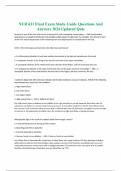
-
NUR 631 Final Exam Study Guide Questions And Answers 2024 Updated Quiz
- Exam (elaborations) • 68 pages • 2024
-
 Labtech
Labtech
-
- $14.99
- + learn more
NUR 631 Final Exam Study Guide Questions And Answers 2024 Updated Quiz Removal of part of the liver leads to the remaining liver cells undergoing compensatory ANS Compensatory hyperplasia is an adaptive mechanism that enables certain organs to regenerate. For example, the removal of part of the liver leads to hyperplasia of the remaining liver cells (hepatocytes) to compensate for the loss. Which of the following statements best describes Raynaud disease? a. An inflammatory disorder of s...

Did you know that on average a seller on Stuvia earns $82 per month selling study resources? Hmm, hint, hint. Discover all about earning on Stuvia


